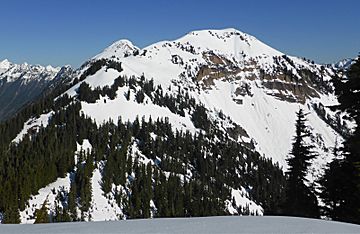Hannegan Peak facts for kids
Quick facts for kids Hannegan Peak |
|
|---|---|

Hannegan Peak, south aspect
|
|
| Highest point | |
| Elevation | 6,191 ft (1,887 m) NAVD 88 |
| Prominence | 467 ft (142 m) |
| Isolation | 1.22 mi (1.96 km) |
| Parent peak | Granite Mountain |
| Geography | |
| Location |
|
| Parent range | North Cascades |
| Topo map | USGS Mount Sefrit |
| Type of rock | rhyolite, breccia |
| Climbing | |
| First ascent | 1893 by Banning Austin, R.M Lyle |
| Easiest route | Hiking trail |
Hannegan Peak is a mountain that stands 6,191 feet (1,887 meters) tall. It is part of the Skagit Range, which is a smaller part of the North Cascades mountains. You can find it in Whatcom County, Washington state.
The peak is just north of Hannegan Pass. It's also about 2.2 miles (3.5 km) north of Ruth Mountain. Both are located in the Mount Baker Wilderness, which is managed by the Mount Baker-Snoqualmie National Forest.
In 1893, Banning Austin and R.M. Lyle were the first to climb Hannegan Peak. They were exploring for a possible road across the Cascades mountains. This road would have gone over Hannegan Pass to Whatcom Pass. The peak was named after Hannegan Pass. The pass itself was named for Tom Hannegan, who was a State Road Commissioner at that time. Even though no road was built, there is a four-mile trail for hikers to the pass. Another one-mile path leads from there to the very top of the peak.
From the summit, you can see many other mountains. These include Mount Shuksan, Ruth Mountain, Mineral Mountain, and Mount Baker. You can also spot Mount Sefrit, Mount Larrabee, Granite Mountain, Mount Chardonnay, Mount Rexford, and the Picket Range.
Weather at Hannegan Peak
Hannegan Peak is in a place with a "marine west coast" climate. This means it gets a lot of moisture from the nearby Pacific Ocean. Most weather fronts, which are like big weather systems, start in the Pacific Ocean. They then travel northeast towards the Cascade Mountains.
As these weather fronts get close to the North Cascades, the tall mountains force the air upward. This process is called Orographic lift. When the air rises, it cools down and drops its moisture. This causes a lot of rain or snow to fall on the Cascades, especially on the western side. Because of this, the west side of the North Cascades gets a lot of rain and snow, especially in winter.
The climate here is mild because it's close to the ocean. Temperatures rarely go below 0°F (-18°C) or above 80°F (27°C). In winter, it's often cloudy. But in summer, high-pressure systems over the Pacific Ocean often bring clear skies. The snow here tends to be wet and heavy. This can create a high risk of avalanches, which are dangerous slides of snow. Water from the mountain flows into streams that eventually reach the Fraser River and the Nooksack River.
How Hannegan Peak Formed
The North Cascades mountains have very rugged shapes. They have sharp peaks, long ridges, and deep valleys carved by glaciers. These different shapes and big changes in height were created by geological events over millions of years. These events also led to the different climates we see today.
The Cascade Mountains started forming millions of years ago, during the late Eocene Epoch. At that time, the North American Plate was slowly moving over the Pacific Plate. This movement caused many volcanic eruptions. You can still see parts of the Hannegan Caldera, which was a huge ancient volcano, on the southeast side of Hannegan Peak. This caldera erupted about four million years ago during the Pliocene epoch. It was an early sign of the volcanic activity that later formed Mount Baker.
Also, about 50 million years ago, small pieces of the Earth's crust, called terranes, came together to create the North Cascades.
During the Pleistocene period, which was over two million years ago, glaciers grew and then melted many times. As they moved, these huge ice sheets scraped and shaped the land. They left behind piles of rock and debris. The U-shaped valleys you see today were carved out by these glaciers. The combination of the land being pushed up (called uplift) and cracks forming in the Earth's crust (called faulting), along with the glaciers, created the tall peaks and deep valleys of the North Cascades area.




